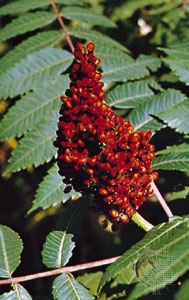sumac
plant
 any of certain species of shrubs and small trees belonging to the cashew family (Anacardiaceae), native to temperate and subtropical zones. All sumacs have a milky or resinous sap, which in a few species can cause a contact dermatitis. Used in the past as a source of dyes, medicines, and beverages, sumacs are now valued as ornamentals, soil binders, and cover plants. The sumacs grown for landscape use display a graceful habit, spectacular fall colour, or colourful fruit clusters.
any of certain species of shrubs and small trees belonging to the cashew family (Anacardiaceae), native to temperate and subtropical zones. All sumacs have a milky or resinous sap, which in a few species can cause a contact dermatitis. Used in the past as a source of dyes, medicines, and beverages, sumacs are now valued as ornamentals, soil binders, and cover plants. The sumacs grown for landscape use display a graceful habit, spectacular fall colour, or colourful fruit clusters.The smooth, or scarlet, sumac (R. glabra), native to the eastern and central United States, is the most common. It grows to a height of 6 metres (20 feet), with an open, flattened crown and a few stout spreading branches. A cultivated variety has much dissected, fernlike leaves. Somewhat taller is the staghorn, or velvet, sumac (R. typhina), up to 9 metres (29.5 feet), named for the dense or velvety covering on new twigs. Its fall foliage is orange-red to purple. It also has a variety with finely cut leaves.
Poison sumac, or poison elder (R. vernix, or in some classifications, Toxicodendron vernix), is an attractive narrow shrub or small tree native to swampy acidic soil of eastern North America. It has whitish waxy berries on loose hanging stalks, unlike the upright reddish, fuzzy fruit clusters of other sumacs. The clear sap, which blackens on exposure to air, is extremely toxic to many people.
The smaller sumacs are the shining, winged, or dwarf sumac (R. copallina) and the lemon, or fragrant, sumac (R. aromatica). The former is often grown for its shiny leaves, the leaflets of which are connected by ribs along the axis, and showy reddish fruits. The fragrant sumac has three-parted leaves, scented when bruised; it forms a dense low shrub useful in landscaping.
The Sicilian sumac (R. coriaria), from the Mediterranean region, is cultivated as a source of tannin in southern Italy.
- Da Lat
- Dalberg, Emmerich Joseph von Dalberg, duc de
- Dalberg, Karl Theodor von
- Dalby
- Dale Carnegie
- Dale Chihuly
- Dale Earnhardt
- d'Alembert's principle
- Dale, Richard
- Dale, Sir Henry
- Daley, Richard J
- Daley, Richard M.
- Daley Thompson
- Dalgaranga Crater
- Dalhousie
- Dalhousie, Fox Maule Ramsay, 11th Earl of
- Dalhousie, James Andrew Broun Ramsay, Marquess and 10th Earl of
- Dalhousie University
- Dali
- Dalian
- Dalin, Olof von
- Dalip Singh
- Dalkeith
- Dallam, Thomas
- Dallapiccola, Luigi